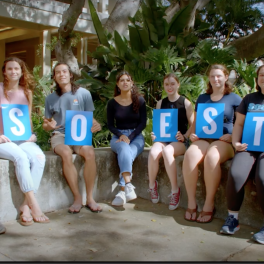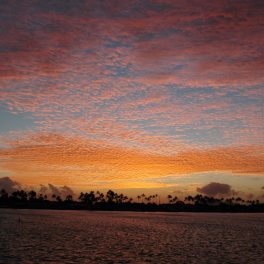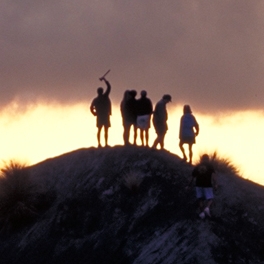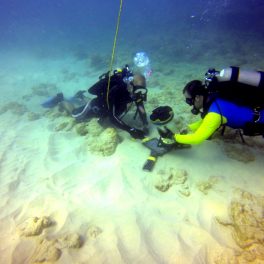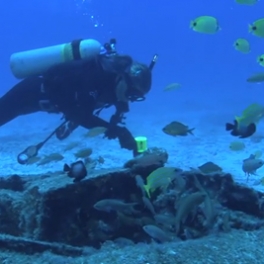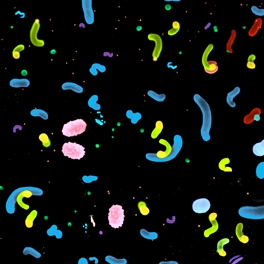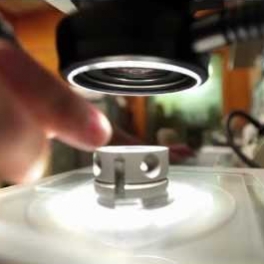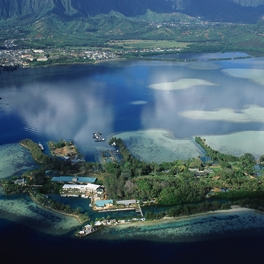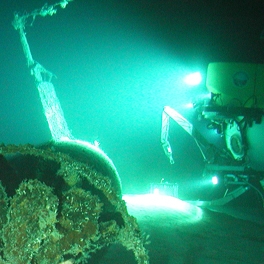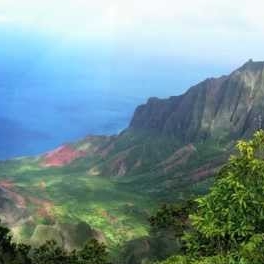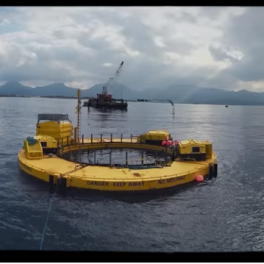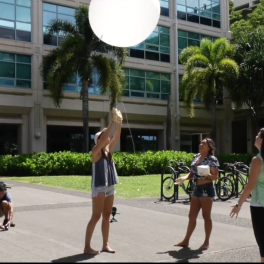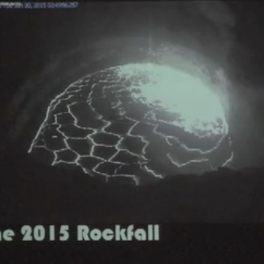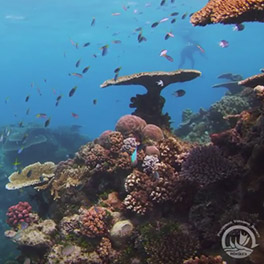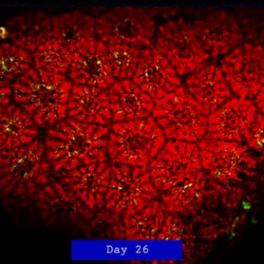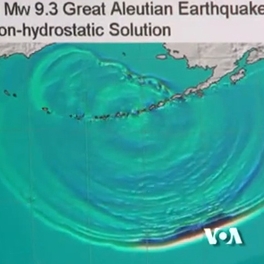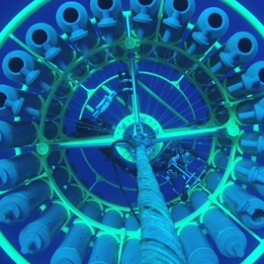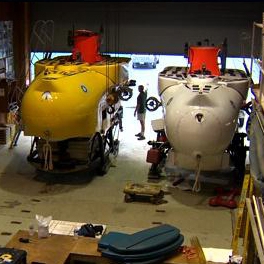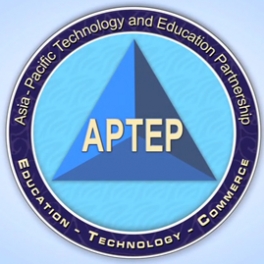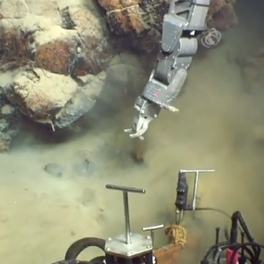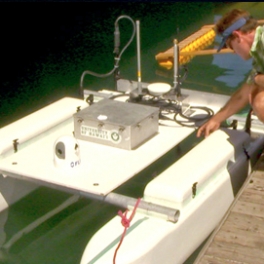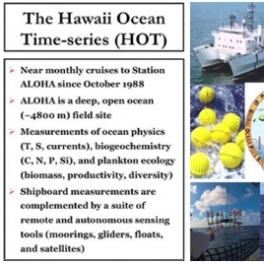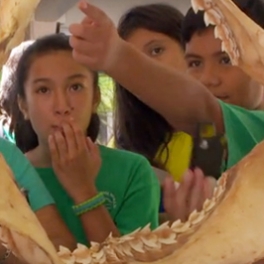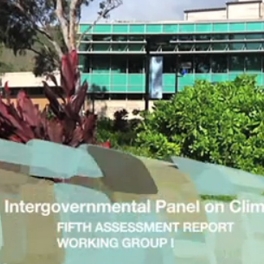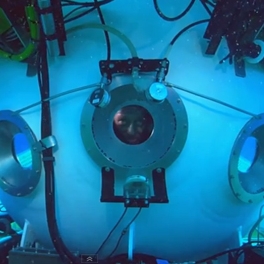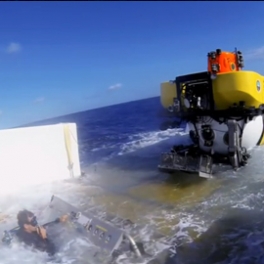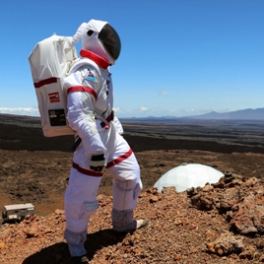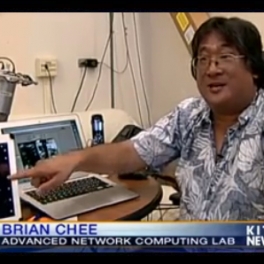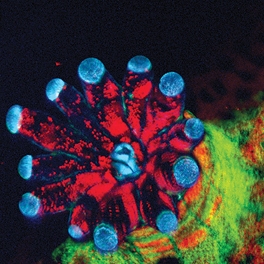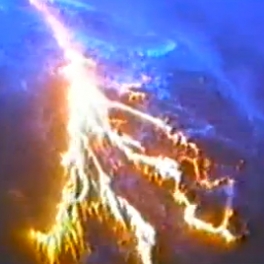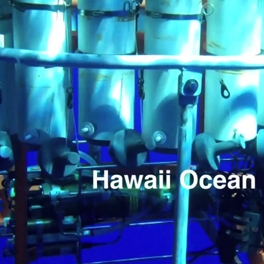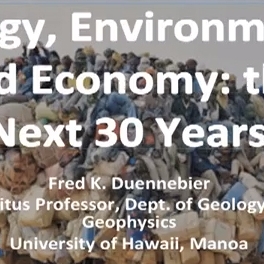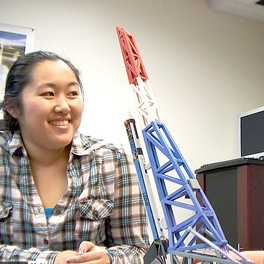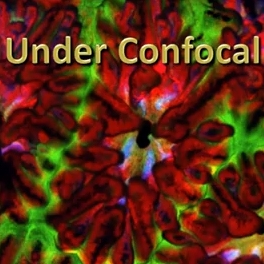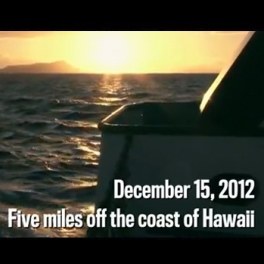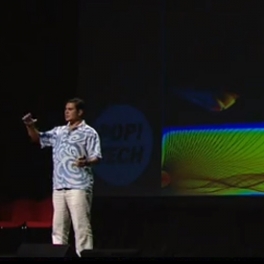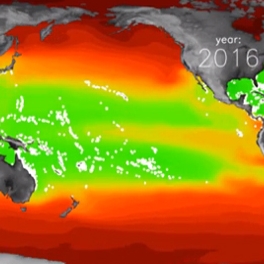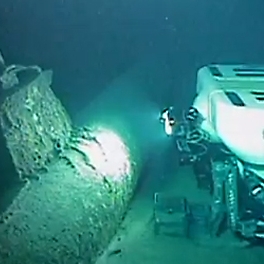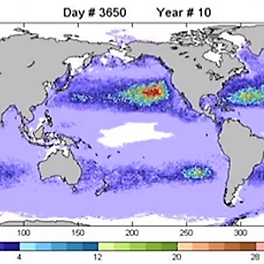Department
-

School of Ocean and Earth Science and Technology (SOEST)
SOEST is a great place for research, innovation, exploration, and education. We are leading advances in understanding the ocean, climate, Earth and planets, and developing technologies to help solve energy and resource issues, and to mitigate natural hazards.
View VideoOcean Life Climate Energy Atmosphere Earth Space -

Department of Atmospheric Sciences
The Department of Atmospheric Sciences has been an academic discipline at University of Hawai‘i at Manoa for over 50 years. The department has built an enviable national and international reputation for excellent research and education opportunities.
View VideoClimate Atmosphere -

Department of Earth Sciences
The Department of Earth Sciences (formerly Geology and Geophysics) has a reputation for high quality education and research through innovative laboratory and field investigations on land and at sea.
View VideoClimate Earth -

Department of Ocean and Resources Engineering
The Department of Ocean and Resources Engineering is known nationally and internationally for the quality of research produced and the educational opportunities offered. Our students come from diverse cultural and academic backgrounds with the common objective to apply their prior education and work experience to ocean-related engineering careers.
View VideoOcean Life -

Department of Oceanography
An introduction to the Department of Oceanography at the University of Hawai‘i at Mānoa (UHM)’s School of Ocean and Earth Science and Technology (SOEST). Learn who we are and how we make a difference on the Blue Planet!
View VideoOcean Life -

Center for Microbial Oceanography: Research and Education (C-MORE)
As an NSF-sponsored Science and Technology Center, C-MORE strives for a more comprehensive understanding of the diversity and ecological role of microorganisms in the sea. C-MORE’s primary mission is Linking Genomes to Biomes.
View VideoOcean Life -

Hawai‘i Institute of Geophysics and Planetology (HIGP)
Through the development and application of innovative technology, HIGP researchers are exploring Earth from the depths of the oceans to the tops of volcanoes, and throughout the solar system including the Moon, Mars, and beyond.
View VideoEarth Space -

Hawai‘i Institute of Marine Biology (HIMB)
Uniquely situated between reef and deep ocean, HIMB is widely recognized for its contributions to marine biological studies in coral reef ecology, conservation biology, molecular evolution, aquaculture, biogeochemistry, bioacoustics, and marine animal behavior physiology.
View VideoOcean Life -

Hawai‘i Undersea Research Laboratory (HURL)
Operating two of only eight deep-diving submersibles in the world, HURL provides safe, efficient, cutting-edge submergence capability. HURL supports proposals to conduct undersea research in waters of the Hawaiian Islands and of the central, southwestern, and western Pacific.
View VideoOcean Life -

Cooperative Institute for Marine and Atmospheric Research (CIMAR)
CIMAR was established to pursue the common research interests of NOAA and University of Hawai‘i in oceanic, atmospheric, and geophysical research. Major areas of research in CIMAR include ecosystem forecasting, ecosystem monitoring, ecosystem-based management, protection and restoration of resources, equatorial oceanography, climate research and impacts, tropical meteorology, and tsunami and other long-period ocean waves.
View VideoOcean Life Climate Atmosphere Earth -

Pacific Islands Ocean Observing System (PacIOOS)
The state of the ocean and beaches throughout the Pacific Islands Region affect our economies, our environment, and public health and safety. PacIOOS provides scientific information needed to positively affect how we live, work and play in, as well as how we care for our ocean home.
View VideoOcean Climate Atmosphere -

University of Hawai‘i Sea Grant
University of Hawai‘i Sea Grant College Program supports an innovative program of research, extension, education, and communication services directed to the improved understanding and stewardship of coastal and marine resources.
View VideoOcean Life Climate Energy Atmosphere Earth
Report
-

HNEI wave energy research and innovation
The ocean has the potential to power our planet – and the race is on to harness it. A video produced by Freethink features University of Hawai‘i at Mānoa wave energy research and innovation. With funding through the Applied Research Laboratory, the Hawaii Natural Energy Institute – HNEI provides critical research and logistical support to the U.S. Navy’s Wave Energy Test Site (WETS), off Marine Corps Base Hawai‘i.
View VideoOcean Energy -

Atmospheric Science Student Research
University of Hawaii at Manoa students in Assistant Professor Alison Nugent’s atmospheric science class launch a weather balloon each semester to learn the state of the upper atmosphere, which is vital for forecasting weather on the ground.
View VideoAtmosphere -

Unheard Sounds of Hawaiian Volcanoes
Milton Garces, director of the Infrasound Laboratory at SOEST’s Hawaii Institute of Geophysics and Planetology, shared the Unheard Sounds of Hawaiian Volcanoes with a group at the Hawaiian Volcanoes National Park recently. Listen around 18:00 for a sampling of sounds from Halema’uma’u.
View VideoEarth -

Kilauea: Up close and personal with red hot science!
Hawai‘i Island’s Kīlauea volcano is one of the best places on Earth to study processes within basaltic volcanoes. Geology professor Mike Garcia has been leading studies of Kīlauea for a generation, adding to the extensive knowledge base on this volcano.
View VideoEarth -

G&G student Haunani Kane fulfills dream on Great Barrier Reef
G&G graduate student and apprentice navigator Haunani Kane is featured in ʻŌiwi TV’s Voyaging for the Future: Great Barrier Reef, exploring the Great Barrier Reef with HIMB coral researcher Ruth Gates and navigator Nainoa Thompson.
View VideoOcean Life Climate -

How to train your coral
Coral bleaching is a huge threat to the planet’s coral reefs. Instead of dwelling on the doom and gloom, Ruth Gates of HIMB is using cutting edge technology to try to understand the processes at work deep inside coral tissues.
View VideoLife Climate -

Sea Level Rise Educational Video
This video by Phil Thompson, associate director of the UHSLC, is part of a science communication-training project to help researchers transform their work into a communications plan that is more accessible for local audiences.
View VideoClimate Earth -

Large fresh water supply discovered on Hawai‘i Island
In March 2013, researchers began drilling at 6400′ above sea level in the saddle region of Hawai‘i Island. What they discovered may radically change conventional wisdom regarding the state’s most valuable resource: fresh water.
View VideoEarth -

Hawai‘i, vulnerable to tsunamis, prepares for the worst
Hawai‘i is vulnerable to tsunamis and is in the forefront of preparations and research, but the devastating 2011 earthquake and tsunami in Japan led Hawai‘i officials to re-evaluate their plans.
View VideoOcean Earth -

Hawai‘i Ocean Time-series : Ocean 180 film submission
The video about the Hawai‘i Ocean Time-series program (based on work published in the journal Nature Reviews Microbiology) is one of ten finalists in the Ocean180 Film Challenge.
View VideoOcean Life -

“UH Oceanography Turns 50: OUR ROOTS”
“UH Oceanography Turns 50: OUR ROOTS” is a presentation by David M. Karl, professor of Oceanography and director of C-MORE, on 23 August 2014 covering the “roots” of the Department from the founding of the University to the founding of the field of study.
View VideoOcean -

Victor and Peggy Pavel Endowed Chair in Microbial Oceanography Celebration
Celebrating the generous estate gifts of Victor and Peggy Pavel, including the establishment of the Victor and Peggy Brandstrom Pavel Endowed Chair in Ocean and Earth Science and Technology at SOEST.
View VideoLife -

UH’s two manned subs may be left on dry land for lack of funds
The Hawai‘i Undersea Research Laboratory (HURL)’s two manned submersibles are among just eight deep-diving human occupied vehicles in the world. But their operations could come to a halt if new funding doesn’t surface.
View Video -

APTEP — Education • Technology • Commerce
HNEI supports the Asia-Pacific Technology and Education Program (APTEP) — centered in Hawai‘i with partnerships in Thailand, Australia, New Zealand, Laos, Vietnam, and Japan — which focuses on the development of alternative energy technologies.
View VideoEnergy -

Ocean expedition maps Lō‘ihi’s deepest reaches
Brian Glazer, associate professor of Oceanography, is interviewed about an expedition to the youngest volcano in the Hawaiian island chain — Lō‘ihi Seamount, southeast of the island of Hawai‘i, and the role submerged volcanoes play in Earth’s history.
View VideoOcean Earth -

SCOPE: $40 million private foundation gift
The Simons Foundation has awarded oceanographers Edward DeLong and David Karl $40 million to lead the Simons Collaboration on Ocean Processes and Ecology (SCOPE), making it the largest private foundation gift UH had received at that point.
View VideoLife -

UH robotic vessel helps in times of disaster
The Unmanned Port Security Vessel (UPSV) is a robotic platform for infrastructure inspection, incident response and recovery, and surveillance in harbors and ports. It was designed and built in Hawai‘i by UH personnel in partnership with Battelle.
View VideoOcean -

The Hawai‘i Ocean Time-series (HOT) program turns 25
In October 2013, the HOT program began its 25th year of sustained ocean measurements at Station ALOHA. The resulting time-resolved suite of measurements fundamentally changed our view of ecosystem variability in the subtropical North Pacific.
View VideoOcean Life -

SOEST’s 2013 Open House excites future scientists
Every two years, SOEST opens its doors to school children and families during a two-day long Open House that exposes kids of all ages to the wonders of science, featuring a wide variety of exhibits, activities, and demonstrations.
View VideoOcean Life Climate Energy Atmosphere Earth Space -

HIMB – Comparative Reef Research
The Seaver Institute awarded researchers at the Hawai‘i Institute of Marine Biology (HIMB) $100,000 to fund a three-year study to discover, document, and characterize deep coral reefs in multiple Pacific locations using advanced rebreather technology.
View VideoLife -

UH Mānoa Briefing on the IPCC AR5 Working Group I Report
IPRC researcher Axel Timmermann and UHSLC director Mark Merrifield presented the Fifth IPCC Climate Assessment Report summary findings. C-MORE director David Karl hosted and moderated. All three are professors of Oceanography.
View VideoClimate -

“How to Launch a 13-Ton Submarine: Part 1” | UnderH2O
In part one of a two-part episode by UnderH2O, we look at the submersible operation at the Hawai‘i Undersea Research Lab (HURL), and meet Terry Kerby, a legend of the underwater world. Terry has been piloting submarines for over 30 years.
View VideoOcean -

-

HI-SEAS mission to “Mars” comes to end
The HI-SEAS 2013 mission was a food study designed to simulate the living and working experience of astronauts on a four-month Mars mission and to compare crew-cooked vs. pre-prepared food systems as thoroughly as possible.
View VideoSpace -

Computer expert Brian Chee explains how to protect online privacy
Not only can hackers access your computer and its files, they can look at you through those built-in cameras. Brian Chee, director of the Advanced Network Computing Lab (ANCL), teaches students about security concepts and techniques.
View Video -

The Microscopic World of Corals | UnderH2O
Scientists at HIMB are using a revolutionary laser scanning confocal microscope to capture images of living corals in a way we have never seen them before, as in this episode of UnderH2O.
View VideoLife -

Pele Meets the Sea
This 27-minute educational video illustrates the subaerial and submarine volcanic activity occurring at Kīlauea Volcano, Hawai‘i. Written and narrated by Oceanography professor Frank Sansone; photographed by Richard Pyle and Jane Culp.
View VideoOcean Earth -

Hawai‘i Ocean Time-series (HOT): The 250th Expedition
In March 2013, the HOT program completed its 250th research expedition. After nearly 25 years of near-monthly sampling, these open-ocean measurements serve as an important barometer of global change. This video was Science 360’s video of the day for 25 April 2013!
View VideoOcean Life -

Energy, Environment, Economy: The next 30 years
A reality driven look at energy, economy and environment, this talk by Geology & Geophysics (G&G) Emeritus Professor Fred Duennebier takes an evidence-based look at the next 30 years. This 02-08-13 talk was part of the G&G TGIF seminar series.
View VideoClimate Energy -

Space is the next frontier for UH
The Hawai‘i Space Flight Laboratory (HSFL) is leading the way in a historic effort: the first ever space launch from the 50th state. The Super Strypi missile will be the culmination of the efforts from UHM, Kaua‘i CC and Honolulu CC.
View VideoSpace -

Senator Daniel K. Inouye Legacy Tribute Ceremony
Video of the ceremony in celebration of the renaming of C-MORE Hale as “The Daniel K. Inouye Center for Microbial Oceanography.”
View VideoOcean Life -

“Observing coral symbiome using laser scanning confocal microscopy”
Congratulations! 2012 International Science & Engineering Visualization Challenge Honorable Mention for Video went to Christine Farrar, Zac Forsman, Ruth Gates, Jo-Ann Leong, and Robert Toonen, all at HIMB.
View VideoLife -

Oceanographer Sylvia Earle on why we need manned ocean explorations
Legendary explorer and oceanographer Sylvia Earle’s last dive with HURL and its two manned submersibles, Pisces IV and Pisces V, in waters around Hawai‘i. She passionately explains why we still need manned ocean exploration.
View VideoOcean -

Senator Daniel K. Inouye (1924–2012)
Senator Inouye was an effective advocate for education, research, and outreach. His efforts have greatly enhanced the capacity for research at UH, especially in the area of marine science, including securing funds to construct the R/V Kilo Moana.
View VideoOcean Life Climate Energy Atmosphere Earth -

Milton Garcés “Primordial Sounds”
HIGP associate researcher Milton Garcés, director of the Infrasound Laboratory, gives a “pop talk” at the AGU 2011 Fall meeting about infrasound: sound generated by many natural phenomena like earthquakes that are too low to be heard by humans.
View VideoAtmosphere Earth -

Encounter with an 18-foot long six-gill shark at a depth of 3,300 feet
Jeff Drazen, Craig Smith, and others captured extraordinary video of an 18-foot deep-sea six-gill shark (Hexanchus griseus) during a 2006 research dive off Moloka‘i. The animal bumped into the HURL submersible while it was at a depth of 3,300 feet.
View VideoLife -

Unprecedented, man-made trends in ocean’s acidity
Aragonite saturation at the ocean’s surface is projected to decrease towards the end of the 21st century as man-made carbon dioxide in the atmosphere continues to rise, according to a study by a team of IPRC scientists.
View VideoClimate -

HURL discovered Japanese midget submarine
In August 2002, HURL discovered the Japanese midget sub that was shot and sunk outside of Pearl Harbor approximately one hour before the air raid on 07 December 1941. The sub was in excellent condition, virtually untouched for over sixty years.
View VideoOcean -

IPRC scientists revise forecast on tsunami debris
IPRC senior researcher Nikolai Maximenko spoke about the current status of the tsunami debris that the Great Tohoku Earthquake generated. Maximenko and scientific computer programmer Jan Hafner predict debris could reach the NW Hawaiian Islands in early 2013.
View VideoOcean Earth





